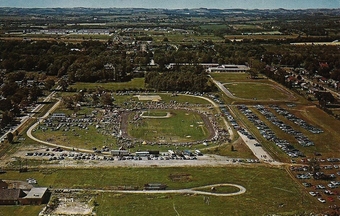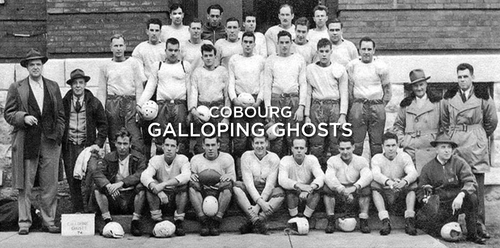
As of 2020, ten of the parks in Cobourg currently have recreational facilities. There are 14 baseball/softball diamonds, 9 soccer fields, 6 tennis courts, 1 lawn bowling club, a canoe/kayaking club, a yacht club, and 1 basketball court. It has taken over 100 years of acquisition to create the park system we know today. Typically, Cobourg's parks began as private properties which were made available, by their owners, for public use.
Donegan Park (previously called Boulton’s Woods, Donegan Park, McClelland Park, Horseshow Park, Kiwanis Park, and then Donegan Park again) has been used for many activities over the years, including horse shows, football, soccer, rugby, softball/baseball, dancing, the Highland Games (est. 1963), skateboarding, and more. In the early years, there was a half mile track around the outside of the park where horse racing and greyhound racing took place. The Galloping Ghosts football team played here from 1935-1953. “Boulton’s Woods” was donated by Daniel Donegan and was formally opened in 1894.
Victoria Park was originally known as Perry’s Common. The land was originally owned by Ebenezer Perry. Perry was the 1st President of the Board of Police of Cobourg, in 1837, and as such is regarded as the 1st Mayor. Mayor J.D. Hayden and Council purchased the land in 1898 and began to develop it as a public park by planting trees, seeding grass and creating walkways. The total cost for the land was $1000 and the trees cost $400. The area was about 25 acres in size.
As the land where the Arlington Hotel, the Chateau Hotel, and Lakeview House had stood became available, they were purchased and became part of the park. The trailer park is located within the park’s boundaries. It was once used by the Lavis family to rent out cabins and canoes. There was a large slide built from the beach out into the water that was operated by the Lavis family.
It has been the home of many sports over the years, such as softball (diamond was demolished following the 2003 season), lawn bowling, beach volleyball, the Highland Games, and other recreational sports such as ultimate frisbee and sandcastle building on the beach. It also has 2 playgrounds, a splash pad, and a basketball court. The Lawn Bowling and Tennis Club was established in 1926. However, the lighted clay tennis courts beside the lawn bowling greens were damaged by Hurricane Hazel, in 1954, and were never replaced.
There was also a wading pool in Victoria Park which was built in 1951 and demolished in the late 1990’s. The Cobourg YMCA has an outdoor pool just west of the bandshell. The Cobourg Harbour, just west of Victoria Park has been home to the yacht club, canoe and kayak club, dragon boat racing, stand-up paddle-boarding, and more. Yachting regattas began in the 1860’s. The harbour was once used for swimming and diving competitions, during the Cobourg Labour Day Games.
Construction for Legion Fields started in 1994 and took 2 years to complete. It cost 1.4 million dollars to build and is a world-class softball facility. It includes 3 clay surface diamonds, two of which have lights. The complex also includes a building containing press/announcement rooms, change rooms, restrooms, a maintenance area, and a canteen. The 3 diamonds were named after Jack Bevan, Clarke Sommerville, and Layton Dodge – all prominent volunteers in the local sporting community.
Marty Cunningham, an Olympic torch relay participant, threw the first pitch at the ribbon cutting ceremony held on July 11, 1996. Deputy Reeve, Bob Spooner, was the master of ceremonies for the event, which concluded with a celebrity game between the Cold Springs Cats Masters team and the Coors Lite Pro Stars, a team made up of professional hockey players. The ribbon cutting ceremony was organized by the Northumberland Whiskey Jacks senior baseball team and the Town of Cobourg.
Legion Fields continues to be the location of many local, provincial, national and international competitions. In 2004, the main building at Legion Fields was named the “Bill O’Neil Pavilion” after Bill O’Neil who was a major sports volunteer in the community, particularly in ball. Bill O’Neil and Layton Dodge were both inducted into the Cobourg & District Sports Hall of Fame in 2019, while Clarke Sommerville was inducted in 2020.
Lion’s Park has 2 full-sized soccer fields and 2 smaller fields for children while the Rotary Field have 2 full size soccer fields and 3 smaller soccer fields. The Lion’s Fields and Rotary Fields were once a part of the old Military Supply Depot, on D’Arcy Street. The land was eventually sold to the Town of Cobourg and developed into soccer pitches by the Cobourg Soccer Club.
Rotary Waterfront Park, locally referred to as the “Frink”, is a fountain in the summertime and is a free outdoor skating rink in the wintertime. This park was built on the site of the Bird Archer plant. When Bird Archer closed, the Town bought the property for $1.00. The plant was demolished and the site de-contaminated. The outdoor rink and washroom were created with the support of the Ontario Government and the Town.
Peter Delanty Park, formerly called Coverdale Park, includes tennis and pickleball courts, a ball diamond, and playground. The 3 tennis courts were donated by the Rotary Club of Cobourg in 1976. The Park was then in Hamilton Township. The ball diamond was where the Cobourg Angels were ‘born’ under the coaching of Paul Currelly.
Sinclair Park has 3 baseball diamonds, tennis courts, and a pickleball court. The tennis courts and washrooms were donated to the Town by the Rotary Club of Cobourg, in 1972.
Westwood Park is currently the home of the Cobourg Saxons Rugby Club. It has a rugby/soccer field and playground.
Morley Cane Park is a leisure park that includes a fenced hardball diamond. Morley Cane ran an electrical appliance shop on Chapel St. and a small outlet on King Street. On Saturday mornings, during the 1940’s and 50’s, he would drive through the streets of Cobourg in his sound truck announcing the Galloping Ghosts game to be played at Donegan Park that afternoon. His sound truck was used for many other sports events, too.
Morley was the Chairman of the Parks and Recreation Board for most of the 1980’s. At that time, it was an independent board, not an advisory committee. The park was named after him in honour of his service to the Town. The Rotary Club of Cobourg, under President Jack Russell, put in the physical labour and funds to complete the ball diamond.
Lucas Point Park and Minnie Pennell Arboretum are naturalized parks that include a variety of walking trails. Minnie Pennell was the driving force in the 1990s behind the Ecology Gardens located just west of Legion Village.
James J. Tracey Park includes a fenced ball diamond, a playground, and community garden. The property was originally owned by the Knights of Columbus. It was deeded to the Town with the provision that it be named after James Tracey who was a Grand Knight for the Father Duffy Knights of Columbus in Cobourg. He was also the District Deputy of the Knights and in charge of three Councils. He was a Town Councilor and very involved in Legion Minor Softball, serving on the Executive.
Fitzhugh Park has a playground and basketball court. The Fitzhugh family were prominent 19th century citizens of Cobourg. They married into the Daintry family and were socially part of the ‘American Colony’, in Cobourg.
The Ecology Garden is a community garden with bird watching locations and is a naturalized area. It was established in 1996. As aforementioned, Minnie Pennell was the driving force behind the creation of Cobourg’s Ecology Garden. She once said, “An ecology garden has a great potential to become an invaluable inspiration and teaching tool for all gardeners, novice or experienced, and will bring together in a safe, pleasant outdoor work environment many different age groups”.
Since its inception, the Ecology Garden has facilitated the mentoring and education of local students who have gone on to university in related fields of ecological research. The garden has provided opportunities for growing vegetables organically, without chemical interventions. The food that has been grown has been donated to United Way agencies, shelters, transition homes, and more. The garden is located just south of Legion Village, along the boardwalk, and faces Lake Ontario. A variety of plants, including flowers, vines and fruits, grow there.
The Honourable James Cockburn Centennial Park, formerly called Rotary Gardens, came to fruition on September 17, 1967. Members of the Rotary Club of Cobourg cut down trees, built a dam, picked stones and used their plows to level and prepare the property as a park. Additional trees were planted and a parking lot created off Elgin Street. Seven Rotarians put up their money to buy a piece of property on the south-east side of the creek to round out the Park area. Over the years it has been used for youth soccer and softball. In 1971, the Rotary Club turned over the deed to the Ganaraska Conservation Authority who are now responsible for its maintenance.
Peace Park is located just west of Ontario Street, south of Tweed Street and north of Tremaine Terrace. Factory Creek is its western border. It has some playground equipment and is used by sport fishermen. It is a popular spot for lake trout and salmon. The park marks the terminus of the walking and hiking board walk promenade which stretches along the west beach and connects to the Marina and Victoria Park walkways.
Many Cobourg parks offer sporting opportunities for its citizens and visitors, of all ages, and are a source of pride for the town.
Updated August 2020


